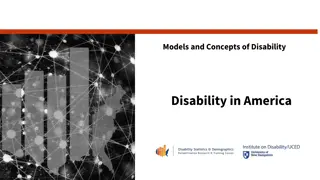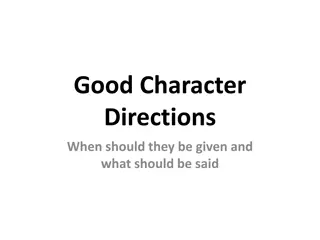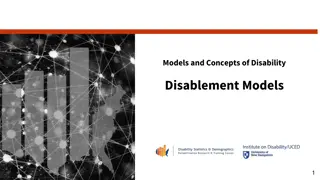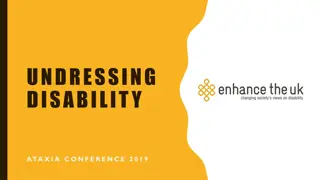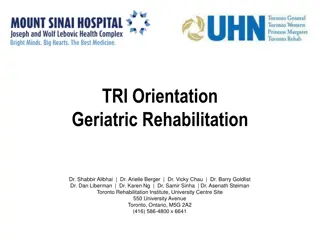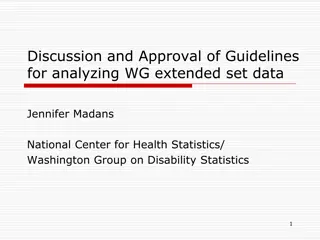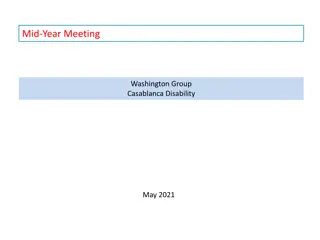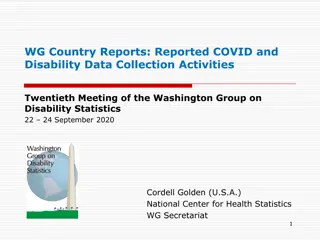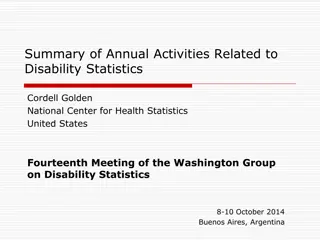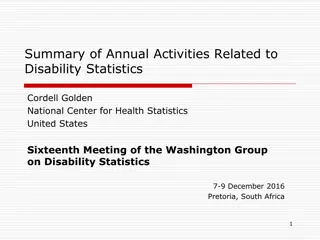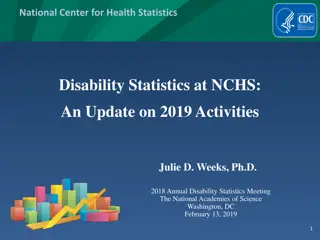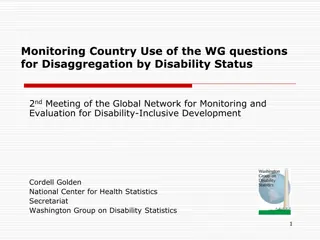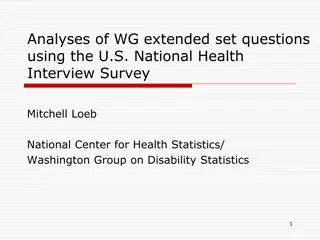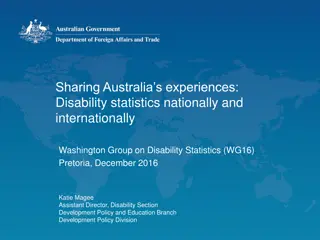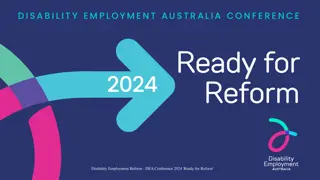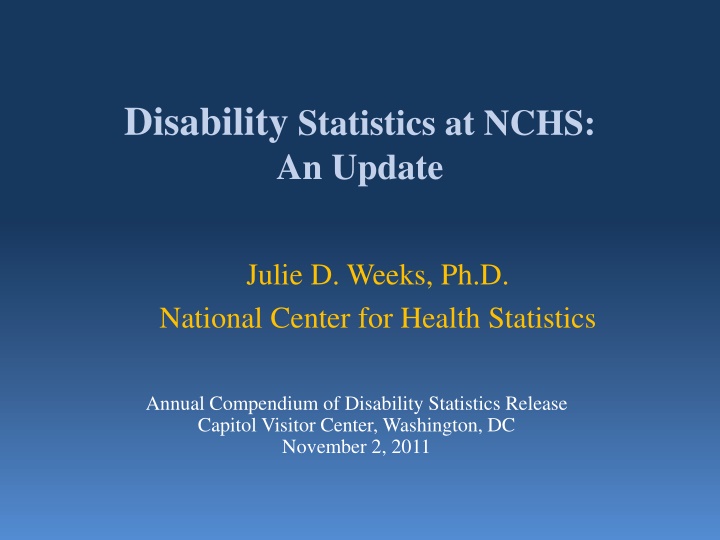
Disability Statistics Update: Ongoing Activities and Future Directions
A comprehensive overview of ongoing disability-related activities, including discussions on the ACA Section 4302 mandates, standard disability measures, and the adoption of ACS as the standard measure of disability for Healthy People objectives. Insights into the Washington Group's purpose in developing internationally applicable disability measures and the evolution of disability statistics for health data collection and research.
Download Presentation

Please find below an Image/Link to download the presentation.
The content on the website is provided AS IS for your information and personal use only. It may not be sold, licensed, or shared on other websites without obtaining consent from the author. If you encounter any issues during the download, it is possible that the publisher has removed the file from their server.
You are allowed to download the files provided on this website for personal or commercial use, subject to the condition that they are used lawfully. All files are the property of their respective owners.
The content on the website is provided AS IS for your information and personal use only. It may not be sold, licensed, or shared on other websites without obtaining consent from the author.
E N D
Presentation Transcript
Disability Statistics at NCHS: An Update Julie D. Weeks, Ph.D. National Center for Health Statistics Annual Compendium of Disability Statistics Release Capitol Visitor Center, Washington, DC November 2, 2011
A number of ongoing disability- related activities ACA Section 4302 meetings Health, U.S. content Healthy People 2020 work groups Washington Group on Disability Statistics National Health Interview Survey content Future directions for measurement and research
ACA Section 4302 2010 Patient Protection and Affordable Care Act: Mandates the collection of data on disability status Requires a standard disability measure Acknowledges disability as a demographic ACA Disability Subcommittee: NCHS member Recommended the 6-question ACS measure as the minimum standard Current status: DHHS solicited public comments on draft standards 10/31/2011: Secretary announced final standards
Health, U.S. and Healthy People Health, U.S.: Historically, used limitation of activity due to a chronic condition In 2009, moved to Basic Actions Difficulties and Complex Activity Limitation (disability measures consistent with current disability models and legislation) Disability used as a demographic in 20+ tables (pain, SRH, alcohol use, no usual source of care, health care visits, insurance, etc.) HP Change in Operational Definition: Include in the core of all applicable Healthy People 2020 population data systems a standardizedset of questions that identify people with disabilities. Adopted ACS as the standard measure of disability for 2020 work HP Objectives tables have disability as a demographic Where possible ACS set used
Washington Group: Purpose Purpose: The promotion and coordination of international cooperation in the area of health statistics by focusing on disability measures suitable for censuses and national surveys which will provide basic necessary disability information throughout the world. Measures must be developed within the framework of a model, culturally comparable, and accepted for use across many countries. Short Set Measure (6 questions): Adopted in 2006 (Uganda meeting) Approx 20 countries planning to/using the SS in census Extended Set Measure (additional functional domains): Adopted in 2010 (Luxembourg meeting) Added to 2010 NHIS
Possible Domains and Activities Mobility Walking Climbing stairs Bending or stooping Reaching or lifting Using hands Sensory Seeing Hearing Communicating Understanding Speaking Cognitive functions Learning Remembering Making decisions Concentrating Emotional functioning Interpersonal interactions Psychological well-being Other Affect Pain Fatigue Self care
WG Disability Short Set 1-5. How much difficulty do you have: seeing even if wearing glasses? hearing even if using a hearing aid? remembering or concentrating? walking or climbing stairs? with self-care, such as washing all over or dressing? 6. Because of a physical, mental or health condition, how much difficulty do you have communicating, for example understanding or being understood by others? a) No, no difficulty b) Yes some difficulty c) Yes a lot of difficulty d) Cannot do at all
National Health Interview Survey Disability Content Basic Actions Difficulties Movement Sensory Emotional Cognitive Complex Activity Limitations Social and leisure activities Perceived ability to work Maintaining independence, including self care and HH chores American Community Survey Set Washington Group Short Set Washington Group Extended Set Upper body movement Learning Affect (anxiety & depression) Pain Fatigue Participation & QOL Measures
Location of NHIS Disability Questions: ACS and WG 2008 (4th quarter) -2009 FDB: ACS questions sample person and family style 2010 FDB: ACS questions person style QOL: WG questions, plus some quality of life / participation measures 2011 FDB: ACS questions person style CDB: ACS questions ADB: ACS questions AFD: WG questions, plus some quality of life / participation measures
What Are We Learning About Disability Questions from the NHIS? 2008 (4th quarter) -2009 FDB: ACS questions sample person and family style Do disability estimates vary by administration style? How? Do NHIS estimates vary from the ACS and CPS? How? 2010 FDB: ACS questions person style QOL: WG questions, plus some quality of life / participation measures Do different question sets yield varying estimates of disability? How? How does participation vary by disability status? 2011 FDB: ACS questions person style CDB and ADB: ACS questions AFD: WG questions , plus some quality of life / participation measures How do disability estimates vary when asked in the family section vs. the sample adult/child sections? How do extended questions on disability operate in a national survey?
Prevalence of Disability by Survey: 2009 NHIS CPS ASEC (%) Family- Style (%) Person- Style (%) ACS (%) Disability Item Ages Vision difficulty 1+ 1.7 2.1 2.4 2.2 Hearing difficulty 1+ 3.1 3.9 4.1 3.4 Mobility difficulty 5+ 6.9 6.6 7.2 6.9 Cognitive difficulty 5+ 3.5 3.9 4.7 4.8 Self-care difficulty 5+ 2.0 1.8 2.2 2.6 Independent living diff 15+ 4.0 4.7 5.1 5.4 Any disability 1+ 11.6 12.0 13.1 12.1 NOTE: CPS data are for population 16 years and over.
Prevalence of Any Disability by Survey and Employment Status*: 2009 30% 24.5 25% 22.1 20.3 20% 16.5 CPS ASEC NHIS, FS NHIS, PS ACS 15% 10% 5.7 5.0 4.7 5% 3.4 0% Employed Not employed * CPS and ACS cover persons 16-64; NHIS covers persons 18-64.
Where Does the ACS Fit In? Basic Action Measures 31.7% Source: NCHS, 2010 NHIS, ages 18+
Where Does the ACS Fit In? Basic Action Measures 31.7% Complex Activity Limitation 15.3% 10.8% Non-Overlap Source: NCHS, 2010 NHIS, ages 18+
Where Does the ACS Fit In? ACS Questions 19.7% Basic Action Measures 31.7% Complex Activity Limitation 15.3% 9.0% Non-Overlap 10.8% Non-Overlap Source: NCHS, 2010 NHIS, ages 18+
Relationship of ACS to Basic Action and Complex Activity Measures 100 90 Movement Difficulty Seeing Hearing Emotional Difficulty Cognitive Difficulty Self Care Social Work 80 70 60 50 40 * 30 20 10 0 ACS Questions Source: NCHS, 2010 NHIS Sample Adult File, Ages 18+
Next Steps in Disability Measurement Incorporating disability measures in more national surveys. Which standard should be adopted ACS or WG? Adding other functioning domains that are not currently included, for example learning and mental health. Development of measures of participation (other than work). Development of measures of the environment. Conduct longitudinal surveys. Conduct disability supplements on single-policy issues.
Washington Group/Budapest Initiative/UNESCAP Activities and Workplan Basic Activity Domains Complex Activity Domains Questionnaire Topic/Type Getting Along with People Communi- cation Cognition/ remembering Upper Body Learning/ understanding ADL/ IADL Life Participation in Society Vision (1) Hearing (1) Mobility Affect Pain Fatigue Activities Row Short Set d a d Capacity Single Questions (1) Extended Set Multiple Questions (1) c c c c b Performance Use of Assistive Devices Micro-E (2) Functioning with Assistance, Micro-E (2) Age at Onset 5 Cause 6 Duration 7 ? ? ? Impact 8 Meso-Environment (3) 9 Macro-Environment (4) To be obtained through other sources, not personal survey data collections 10 ICF Chapter Reference - Activities/Participation (5) See Note below ICF-1 ICF-1 ICF-4 ICF-3 ICF-1,2 ICF-4 ICF-1 ICF-2 ICF-5,6 ICF-7 ICF-8 ICF-9
Thank you! Questions?
The ACS Disability Measures For sample persons 1 year of age and older: 1. Is this person deaf or does he/she have serious difficulty hearing? 2. Is this person blind or does he/she have serious difficulty seeing? For sample persons 5 years of age and older: 3. Because of a physical, mental, or emotional condition, does this person have serious difficulty concentrating, remembering or making decisions? 4. Does this person have serious difficulty walking or climbing stairs? 5. Does this person have difficulty dressing or bathing? For sample persons 15 years of age and older: 6. Because of a physical, mental, or emotional condition, does this person have difficulty doing errands alone such as visiting a doctor s office or shopping? Response Categories: 1. Yes 2. No
Equalization of Opportunities Employed (%) Seeks to identify all those at greater risk than the general population for limitations in participation. 90 Proportion (%) 60 30 Disability used as a demographic. 0 Nondisabled Disabled

